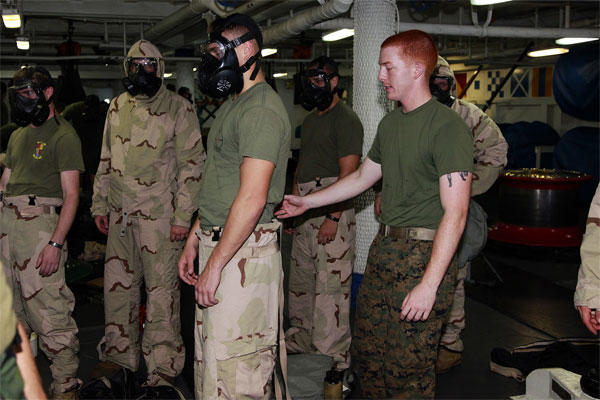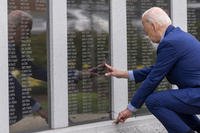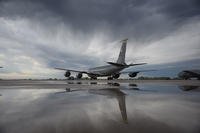The 15th MEU’s Chemical, Biological, Radiological and Nuclear Defense Platoon is spending an entire month preparing the 2,400 servicemembers who make up the MEU on how to properly operate in contaminated environments.
“The class we are teaching helps prepare Marines and sailors against CBRN threats they could come across while serving overseas,” said Lance Cpl. James R. Kerr, CBRN defense specialist, CBRN Platoon, 15th MEU. “It’s important for them to know how to react appropriately to contaminated environments and how to conduct missions in mission oriented protective posture gear,” added the 19-year-old native of Boston.
Mask confidence exercises are annual requirements for Marines and are designed to increase their proficiency using their masks in a controlled, contaminated gas chamber. However, the course the CBRN Platoon is conducting on ship focused on the Marines learning the correct way to remove MOPP gear, decontamination procedures and the different tools the CBRN Marines use in contaminated environments.
“This was an excellent refresher of skills using MOPP gear and the decontamination process,” said Master Sgt. Jason C. Benedict, operations chief, Weapons Company, Battalion Landing Team 3/5, 15th MEU. “There are certain countries that have chemical weapons, and we could be employed to take charge, safeguard and control the area,” added the 36-year-old native of West Milford, N.J.
While it isn’t the most common threat, some Marines have conducted operations in contaminated environments, which make this training more relevant than many realize.
“I feel prepared to execute a mission in a contaminated environment,” said Staff Sgt. Daniel W. Fauset, fire support coordination center chief, BLT 3/5, 15th MEU. “I operated in a suit in Operation Iraqi Freedom II, so it’s good that we are practicing the proper procedures should the need arise,” added the 28-year-old native of Atascadero, Calif.
The class also covered the use of some of the tools CBRN Marines use, such as reactive skin decontamination lotion, a neutralizer for a Marine or sailor who comes in contact with a chemical agent; M9 tape, which is attached to a rifle or servicemember to alert CBRN Marines of possible contamination; M8 paper, which can detects two nerve agents and one blister agent and also changes colors to let CBRN Marines know which threat is present and the most accurate tool, which is the joint chemical agent detector. This equipment provides nerve, blister agent and toxic industrial chemical detection capabilities.
“This was a really good class,” said Lance Cpl. Jesse P. Schlosser, radio operator, Weapons Company, BLT 3/5, 15th MEU. “We learned about some of the different chemical detection agents and how to employ them in a contaminated environment. I’m glad we learned how to protect ourselves,” added the 21-year-old native of Frederick, Md.
After the conclusion of class, Marines spent time practicing the removal of the MOPP gear and set up a detailed troop decontamination site.
“The training we provided today ensures Marines who enter a potentially chemically dangerous environment don’t contaminate others when they return,” said Sgt. William A. Bonilla, assessment consequence management team member, CBRN Platoon, 15th MEU.
The 15th MEU is currently embarked as part of the Peleliu Amphibious Ready Group, while they serve as the nation's rapid-response sea-based Marine Air Ground Task Force for Western Pacific Deployment 12-02.
ABOARD USS PELELIU — GAS! GAS! GAS! Marines and sailors with the 15th Marine Expeditionary Unit armed themselves with their M50 field protective masks for a different type of training to prepare for a variety of threats they could encounter during their deployment, WestPac 12-02, Oct. 4.





























